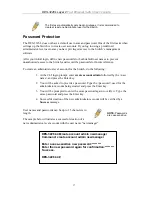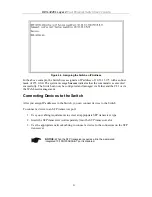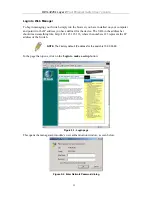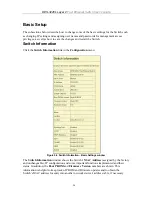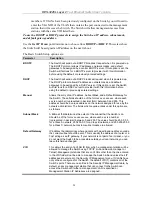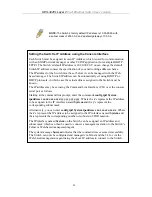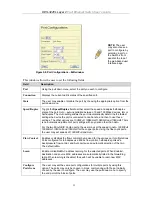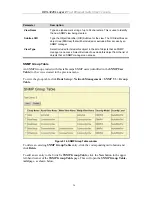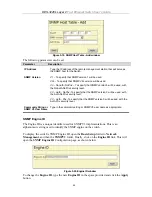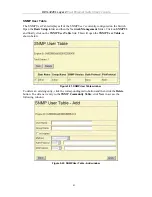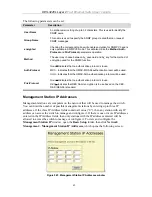
DES-3226L Layer 2
Fast Ethernet Switch User’s Guide
members. If VLANs have been previously configured on the Switch, you will need to
enter the VLAN ID of the VLAN that contains the port connected to the management
station that will access the Switch. The Switch will allow management access from
stations with the same VID listed here.
To use the BOOTP or DHCP protocols to assign the Switch an IP address, subnet mask,
and default gateway address:
Use the
Get IP From:
pull-down menu to choose from
BOOTP
or
DHCP
. This selects how
the Switch will be assigned an IP address on the next reboot.
The Basic Switch Setup options are:
Parameter
Description
BOOTP
The Switch will send out a BOOTP broadcast request when it is powered up.
The BOOTP protocol allows IP addresses, network masks, and default
gateways to be assigned by a central BOOTP server. If this option is set, the
Switch will first look for a BOOTP server to provide it with this information
before using the default or previously entered settings.
DHCP
The Switch will send out a DHCP broadcast request when it is powered up.
The DHCP protocol allows IP addresses, network masks, and default
gateways to be assigned by a DHCP server. If this option is set, the Switch
will first look for a DHCP server to provide it with this information before
using the default or previously entered settings.
Manual
Allows the entry of an IP address, Subnet Mask, and a Default Gateway for
the Switch. These fields should be of the form xxx.xxx.xxx.xxx, where each
xxx is a number (represented in decimal form) between 0 and 255. This
address should be a unique address on the network assigned for use by the
network administrator. The fields which require entries under this option are
as follows:
Subnet Mask
A Bitmask that determines the extent of the subnet that the Switch is on.
Should be of the form xxx.xxx.xxx.xxx, where each xxx is a number
(represented in decimal) between 0 and 255. The value should be 255.0.0.0
for a Class A network, 255.255.0.0 for a Class B network, and 255.255.255.0
for a Class C network, but custom subnet masks are allowed.
Default Gateway
IP address that determines where packets with a destination address outside
the current subnet should be sent. This is usually the address of a router or a
host acting as an IP gateway. If your network is not part of an intranet, or you
do not want the Switch to be accessible outside your local network, you can
leave this field unchanged.
VID
This allows the entry of a VLAN ID from which a management station will be
allowed to manage the Switch using TCP/IP (in-band via web manager or
Telnet). Management stations that are on VLANs other than the one entered
in the VID field will not be able to manage the Switch in-band unless their IP
addresses are entered in the Security IP Management menu. If VLANs have
not yet been configured for the Switch, the default VID (1) contains all of the
Switch’s ports. There are no entries in the Security IP Management table, by
default, so any management station that can connect to the Switch can
access the Switch until either a management VLAN is specified or
Management Station IP Addresses are assigned.
28




